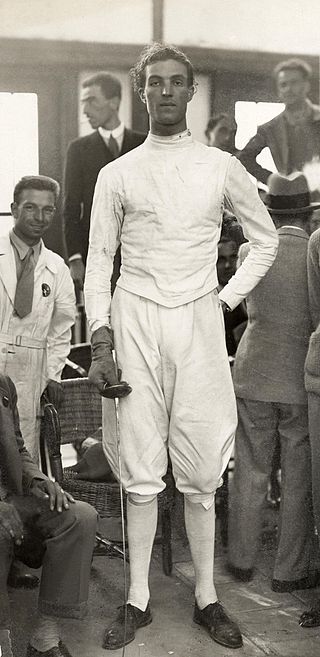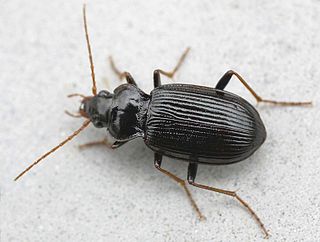
Italy competed at the 1928 Summer Olympics in Amsterdam, Netherlands. 174 competitors, 156 men and 18 women, took part in 81 events in 15 sports.

Italy competed at the 1936 Summer Olympics in Berlin, Germany. 244 competitors, 228 men and 16 women, took part in 99 events in 17 sports.

Giulio Gaudini was an Italian foil and sabre fencer. He competed at the 1924, 1928, 1932 and 1936 Olympics and won three gold, four silver, and two bronze medals. He was the flag bearer for Italy at the 1936 Games. At the world championships, he earned 17 medals between 1929 and 1938. He died of cancer, aged 43.
Gaudyny is a village in the administrative district of Gmina Pieniężno, within Braniewo County, Warmian-Masurian Voivodeship, in northern Poland. It lies approximately 8 kilometres (5 mi) north of Pieniężno, 21 km (13 mi) south-east of Braniewo, and 62 km (39 mi) north-west of the regional capital Olsztyn.

Nebria is a genus of ground beetles native to the Palearctic, the Near East and North Africa. There are more than 500 described species in Nebria.

Nebria brevicollis, belonging to the Carabidae family, is a ground beetle. With nearly 500 species and over 100 subspecies, N. brevicollis is the most diverse genus within the Nebriini tribe of ground beetles. Members of the genus occupy a wide range of habitats. Nebria brevicollis is native to Europe and the Near East but has been introduced to the western United States and Canada. Its rapid expansion in North America is characteristic of an invasive species. Due to the variation in habitat, their diet consists of small arthropods including Collembola, Diptera, earthworms, mites, and spiders.

Nebria livida is a species of ground beetle with two subspecies:

The men's foil was one of seven fencing events on the Fencing at the 1928 Summer Olympics programme. It was the seventh appearance of the event. The competition was held from 31 July 1928 to 1 August 1928. 54 fencers from 22 nations competed. For the third straight Games, the limit of fencers per nation was reduced. The event was won by Lucien Gaudin of France, the nation's second consecutive and fourth overall victory in the men's foil. Erwin Casmir earned silver to give Germany its first medal in the event. Giulio Gaudini of Italy took bronze.

The men's foil was one of seven fencing events on the fencing at the 1932 Summer Olympics programme. It was the eighth appearance of the event. The competition was held from 2 to 4 August 1932. 26 fencers from 12 nations competed, with one other entered but not starting. Each nation was limited to three fencers. The event was won by Gustavo Marzi of Italy, the nation's third victory in the men's foil. His countryman Giulio Gaudini took bronze for the second consecutive Games, becoming the fourth man to win multiple medals in the event. Joe Levis gave the United States its first men's foil medal with his silver.

The men's foil was one of seven fencing events on the fencing at the 1936 Summer Olympics programme. It was the ninth appearance of the event. The competition was held from 5 August 1936 to 6 August 1936. 62 fencers from 22 nations competed. Nations were limited to three fencers. The event was won by Giulio Gaudini of Italy, the nation's second consecutive and fourth overall victory in the men's foil. Gaudini, who had won bronze medals in 1928 and 1932, was the first man to win three medals in the event. His countryman Giorgio Bocchino took bronze. Edward Gardère put France back on the podium after a one-Games absence.

Nebriinae is a subfamily of ground beetles in the family Carabidae. There are about 12 genera and more than 840 described species in Nebriinae.
Nebria aetolica is a species of ground beetle in the Nebriinae subfamily that can be found in Albania, Greece, and North Macedonia.
Nebria dahlii is a species in the beetle family Carabidae, found in Europe.
Nebria germarii is a species of ground beetle in the Nebriinae subfamily that can be found in Austria, Germany, Italy, Liechtenstein, Switzerland, and in every state of former Yugoslavia, except for North Macedonia.
Nebria peristerica is a species of ground beetle in the Nebriinae family that can be found in Greece and North Macedonia.
Nebria lariollei is a species of beetle in the family Carabidae that is endemic to France.
Nebria lariollei lariollei is a subspecies of beetle in the family Carabidae that is endemic to France.
Nebria laticollis is a species of ground beetle in the Nebriinae subfamily that can be found in France, Italy, and Switzerland.
Nebria cordicollis is a species of black coloured ground beetle from Nebriinae subfamily that can be found in Switzerland, Italy, and Germany. The species is about 5 millimetres (0.20 in) long.
Monotherium is an extinct genus of phocid belonging to the subfamily Monachinae. It is known from fossils found in the middle to late Miocene of Belgium.







